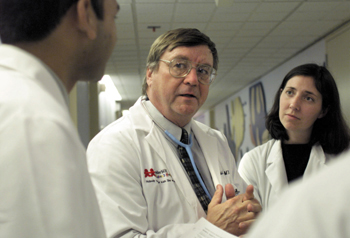
Dr. Arnold Strauss, chair of Pediatrics, believes that particular genes in children trigger heart disease. Strauss is one of the nation's leading authorities in pediatric cardiology research. (photo by Dana Johnson)
Strauss focuses on curing heart disease in children
Heart disease in children has always been a mystery.
The general theory once held was that it just happened, for no apparent reason. It wasn’t a theory Dr. Arnold W. Strauss believed. He hypothesized that particular genes in a child often triggered heart disease. Ten years later, science has caught up with his theory.
Strauss, James C. Overall Professor and Chair of Pediatrics, and director of Vanderbilt Children’s Hospital, is one of the nation’s leading authorities in the field of pediatric cardiology research. His research has helped Vanderbilt become one of the top three research facilities in the country in pediatric cardiology. Strauss also has the only research lab in the world that can determine genetic defects to diagnose fatty acid disorders in children.
His research in molecular genetics of cardiac energy supply, fatty-acid oxidation disorders and genetic causes of cardiomyopathy in children has secured Vanderbilt as one of the five National Institute of Health’s Specialized Centers of Research in molecular and gene causes of heart disease in children.
"At Vanderbilt our focus is on the structure of the heart and congenital defects," Strauss explained. "We have helped to identify genes which cause structural defects in the heart."
Dubbed the 'tin man' gene, Strauss said it was discovered and isolated in flies, which were born without hearts. Further research showed the same characteristics in mice and humans. Since that gene was discovered, four additional genes have also been shown to cause structural defects.
Cardiomyopathy, a disease of the heart muscle, causes the heart to lose its ability to pump blood. In some instances, heart rhythm is disturbed, leading to irregular heartbeats, or arrhythmias. Usually, the exact cause of the muscle damage is never found. In 1994 Strauss identified 10 to 15 genes that help cause this defect.
"We focused on heart defects that can't break down fat," he said. "Fat is critical for function in the heart. It helps to generate energy. Considering that a mother's milk is 60 percent fat and if the enzymes can’t break that fat down, the child is in trouble."
Strauss said screening for this defect could become common place, because a change in the child's diet, lowering the fat content, would have a very high impact on the child’s quality of life.
Strauss, who has been at Vanderbilt just over six months, said the Vanderbilt Children’s Hospital and pediatric research have the potential to be the best in the country.
"We need to double our research funding and we can do that," he said. "In the next two years we'll be recruiting 10 to 12 researchers to help in lab research. We need to develop physicians who are scientists to focus on developmental biology. Defects are the most common cause of death and we have the tools to research this further."













